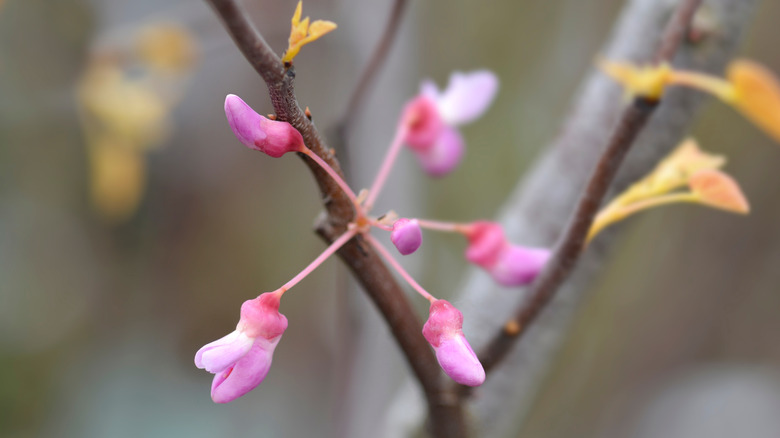Plant This Breathtaking Tree Now And Enjoy Endless Sunrise Vibes All Spring
Now is the time to add tasks to your fall-to-do list for the garden of your dreams. For instance, you could plant bright and happy spring-blooming bulbs like crocus, daffodils, and tulips. Get them into the ground this season, and you'll be greeted with colorful blooms in a few months' time, bringing vibrancy to your garden after winter's end.
For even more spectacular spring color that will liven up your yard, try introducing the Rising Sun Eastern Redbud tree (Cercis canadensis 'JN2') to your yard this fall. One of spring's earliest bloomers, this Eastern Redbud cultivar produces a breathtaking show of pink blossoms that will cover its bare branches for several weeks. Not to be outdone, its leaves emerge first as orange. Mimicking the rising sun, they transition through many lovely hues, changing to peach, then bright yellow, followed by chartreuse, and then an eye-catching lime green — it's not uncommon for one tree to sport multiple leaf colors at once.
In fall, it boasts an eye-catching mix of yellow and orange foliage. Plant a Rising Sun several weeks before the first frost in autumn, and it will amaze you with how vibrant it looks in springtime. Redbuds are native to eastern North America and the Rising Sun is hardy in zones 4 through 9. A compact ornamental tree, it will only reach 8 to 12 feet, making it ideal for small yards.
How to plant the Rising Sun tree
The Rising Sun adapts well to a variety of soil conditions and tolerates both full sun and partial shade. It will flower most prolifically when planted in a spot that gets at least a few hours of direct sunlight daily. You'll enjoy watching pollinators like birds, butterflies, and bees flock to your yard to feast on its fragrant flowers. This cultivar has a few drawbacks: The large seed pods it produces after flowering can persist through winter, and its branches can break from dryness or harsh winds, so it's a good idea to situate it in a location shielded from stiff breezes.
To plant a Rising Sun sapling in fall, make sure you start before the first frost. Dig a hole at least twice as wide as the root ball and deep enough so the trunk flare (where the trunk meets its roots) sits just above the soil line. Loosen the dirt with your shovel and relocate any rocks. Remove the tree from its container and gently spread its roots out, positioning the tree upright in the hole. Fill the hole halfway with the dirt that was removed from it, then gently tamp down the soil to remove air pockets and ensure good soil-to-root contact. Water the tree and then replace the rest of the dirt. Add a 3 to 4-inch-deep layer of mulch around the sapling to keep the soil moist. Avoid piling mulch against the tree, as it can promote decay. Space these trees at least 12 feet apart when planting more than one to provide plenty of room to grow. After experiencing this Eastern Redbud cultivar, you may want to explore the many others that are also available.

